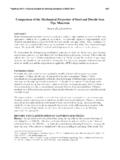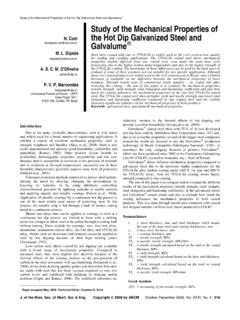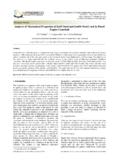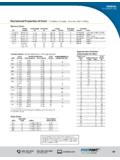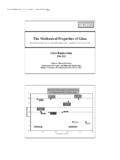Transcription of Mechanical Properties of Steel Bolts, Screws and Studs ...
1 Technical InformationJAM BUILDING Metals used in fastener manufacture are elastic materialswhich will stretch (elongate) under applied loads and returnto their original shape when the load is removed. However,if sufficient load is applied, the material will stretch beyondits yield point and enter a plastic zone, losing its elasticityand becoming permanently stretched. Further increased loadon the material will stretch it to its ultimate tensile strength atwhich point the material will fracture. The major factor in determining the load a material cancarry is its tensile strength, which is related to its terms used to describe the strength and load bearingproperties of a metal fastener are:Tensile Strength is an expression of the maximum capaci-ty of a particular material to stretch under tension loadprior to Stress (Yield Point) is an expression of the theoreti-cal point of stress (pressure) beyond which the materialloses its elasticity and becomes permanently stretched(realistically, a range rather than a single point).
2 Proof Load Stress is an expression of the minimum stressa material must achieve, prior to permanent elongationand, the stress which would be applied to test and remea-sure a specific fastener to prove it had not permanentlystretched and that it will carry the required load. Theseterms will also include a unit of area, are approximatelybetween 80% and 90% of the theoretical yield stress andare expressed in the same terms. Proof load stresses alsoapply to nuts and are the point at which the nut is deemedto have Tensile Stress is the theoretical minimum pointat which the material will fracture. It is expressed in thesame terms as yield stress and proof load stress. These prop-erties are used to calculate the proof load and breaking loadfor each diameter of each grade or class of Bolt TensioningThe following chart pictorially demonstrates the typical ten-sion/elongation relationship, the various zones of elonga-tion and points of tension.
3 Elastic Elongation: elongation from which the fastenerwill recover when load is removed. Plastic Elongation: elongation which is permanent andrenders the fastener non-reusable. Necking Elongation: elongation past the tensile strengthof the fastener from where the diameter is reducing, thetension is decreasing and fracture results. Minimum Tension: the minimum tension used for designpurposes = 65-70% of proof load and is the theoreticalminimum tension the recommended tightening torqueshould achieve. Proof Load: the minimum point prior to permanent elon-gation and the test point for actual proof load testing. Yield Point: the point at which elasticity is lost and per-manent elongation commences. Tensile Strength: the maximum load-carrying point priorto Designation of Property property classes and their Mechanical Properties applyto bolts, Screws and Studs , with metric (ISO) thread, withnominal thread diameter d 39mm, made of carbon steelor alloy Steel and when tested at room property class symbols, indicating the most importantmechanical Properties , consist of two figures, one on eitherside of a dot.
4 For example, , the first figure indicates1/100 of the nominal tensile strength in N/mm2. (See Rm,nomin the table of next page) So property class has a tensilestrength of 8 x 100 = 800 N/mm2. The second figure indi-cates 10 times the ratio between lower yield stress ReL(orproof stress ) and nominal tensile strength Rm, nom(yieldstress ratio). So at property class the second figure 8 =10 x 800/1000. The multiplication of these two figures willgive 1/10 of the yield stress in N/mm2, so 8 x 8 = 1/10 x640 Properties of Steel Bolts, Screws and Studs1. Basic - Creativity in FasteningJAM BUILDING PRODUCTST echnical Information8-93. Mechanical and Physical Properties of Steel Bolts, Screws and Studs in accordance with ISO898-1:1999 is given - Creativity in FasteningTechnical InformationJAM BUILDING PRODUCTS4.
5 Marking of Bolts, Screws and Studs - Marking of all property classes is obligatory for hexagon boltsand Screws with nominal diameters d 5mm, preferably ontop of the Studs shall be marked for property classes and withnominal diameter 5mm. For Studs with interference fit, themarking shall be at the nut end. - The trade (identification) marking of the manufacturer ismandatory on all products which are marked with For other types of bolts and Screws the same marking systemshall be used. For special components marking will be asagreed between the interested Properties of Steel Nuts1. The property classes and their Mechanical Properties men-tioned below apply to nuts with metric ISO thread withnominal thread diameters up to and including 39mm, andheights not less than (including the normal counter-sunk on the thread), made of carbon Steel or low alloy steeland when tested at room does not apply to nuts which have to meet specialrequirements, such as for weldability, corrosion resistance,ability to withstand temperatures above + 300oC or below -50oC or locking.
6 Nuts made from free-cutting Steel shall notbe used above +250oC. There is an increased risk of strip-ping for assemblies with threads having wider use for nuts above 39mm is only permitted, when thenuts meet all the Designation of Property ClassesThe symbol for property classes consists of a figure thatindicates 1/100 of the proof load stress in class 8 has a proof load stress of 8 x 100 = 800 proof load stress is equal to the minimum tensilestrength of a bolt, which can be loaded up to the minimumyield strength of the bolt when mated with the nut of a higher property class can generally be used in theplace of nuts of a lower Mechanical Properties of Steel Nuts in accordance withBS3692:2001 is given below:4. Marking of Nuts Hexagon nuts M5 shall be marked with the symbol of theproperty class, and the trade (identification) marking of themanufacturer on the bearing surface or - Creativity in Fastening
